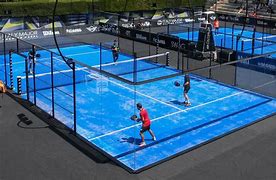

Exploring the Growing Popularity of Padel in China The Role of Padel Racket Courts
In recent years, the sport of padel has been gaining momentum across the globe, and China is no exception. Starting as a niche sport, padel is rapidly transforming into a mainstream recreational activity, particularly in urban areas. As cities become more populated and the demand for diverse sporting options increases, padel racket courts are emerging as a significant feature of China’s sports landscape.
What is Padel?
Padel is a racket sport that combines elements of tennis and squash. It is typically played in doubles on an enclosed court that is roughly one-third the size of a traditional tennis court. The game is played with solid rackets and a low-compression ball, and the walls surrounding the court play a crucial role in the gameplay, allowing for strategic play and exciting rallies. This unique blend of accessibility and competitive spirit has made padel appealing to a wide range of players, from families looking for fun to serious athletes.
The Rise of Padel in China
The rise of padel in China can be attributed to several factors. Primarily, the sport's inclusive nature makes it suitable for players of all ages and skill levels. This accessibility encourages participation, drawing in not only seasoned athletes but also newcomers eager to embrace a fresh sporting challenge. Additionally, padel's social aspect fosters community engagement, with many courts offering facilities for players to relax and socialize post-game.
As more people become aware of the sport, the demand for dedicated padel racket courts has surged. Major Chinese cities such as Beijing, Shanghai, and Shenzhen have witnessed the establishment of numerous padel clubs and facilities, catering to the burgeoning interest. These courts are often integrated into existing sports complexes or designed as standalone venues, contributing to the overall enhancement of urban sports infrastructure.

Economic Impact
The growing popularity of padel in China is also having a positive economic impact. The construction of padel racket courts creates job opportunities ranging from court maintenance to coaching and event management. Moreover, as more people engage with the sport, a new market for sports equipment emerges. Local businesses are beginning to manufacture and sell padel rackets, balls, and apparel, further stimulating economic growth.
Community and Events
To nurture this growing interest, numerous padel tournaments and events are being organized around the country. These competitions not only showcase local talent but also help to create a vibrant sporting community. Players come together to share their experiences, improve their skills, and foster camaraderie. Schools and universities are also starting to incorporate padel into their physical education programs, helping to further popularize the sport among younger generations.
Looking Ahead
The future of padel in China looks promising. With increasing investments in sports infrastructure and a growing interest among the youth, the sport is poised to expand even further. As the infrastructure for padel develops, including specialized coaching and training programs, China might soon see its first professional players making waves on the international stage.
In conclusion, the advent of padel racket courts marks an exciting chapter in China’s sports evolution. With its unique charm and inclusive nature, padel is not just a passing trend but a sport that supports community engagement, economic growth, and active lifestyles. As more players take to the courts, the anticipation builds for what’s next in this thrilling new sports movement in China.
Industrial Flooring Solutions for Factories & Racquetball Courts Safe & Durable
Premium Rubber Floor Mats Slip-Resistant, Durable & Easy Clean
Industrial Flooring Solutions for Outdoor Paddle Tennis Courts & Factories
Industrial Flooring Solutions Durable Padel Court Supplier & Installation
Rubber Composite Flooring Durable, Slip-Resistant Floor Mats
Premium PVC & Rubber Sports Flooring Shock Absorption, Slip Resistance